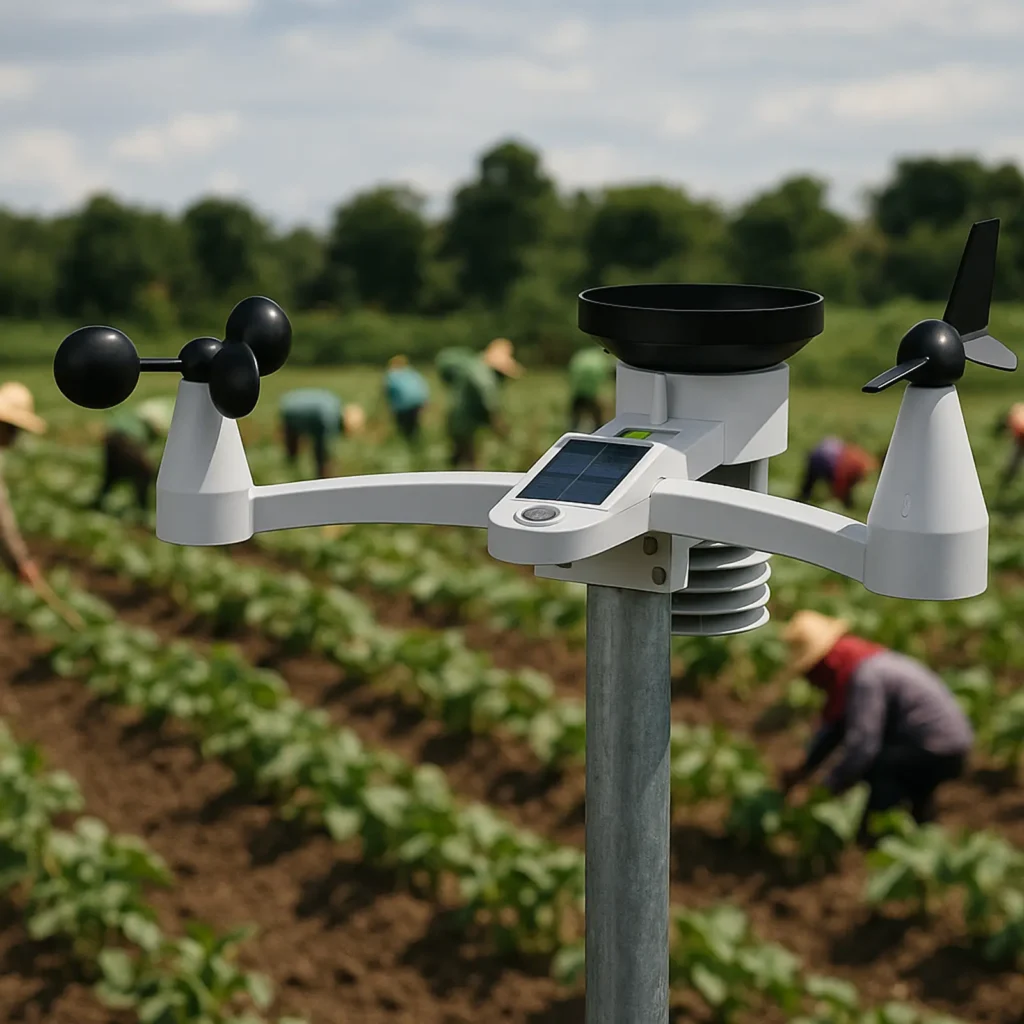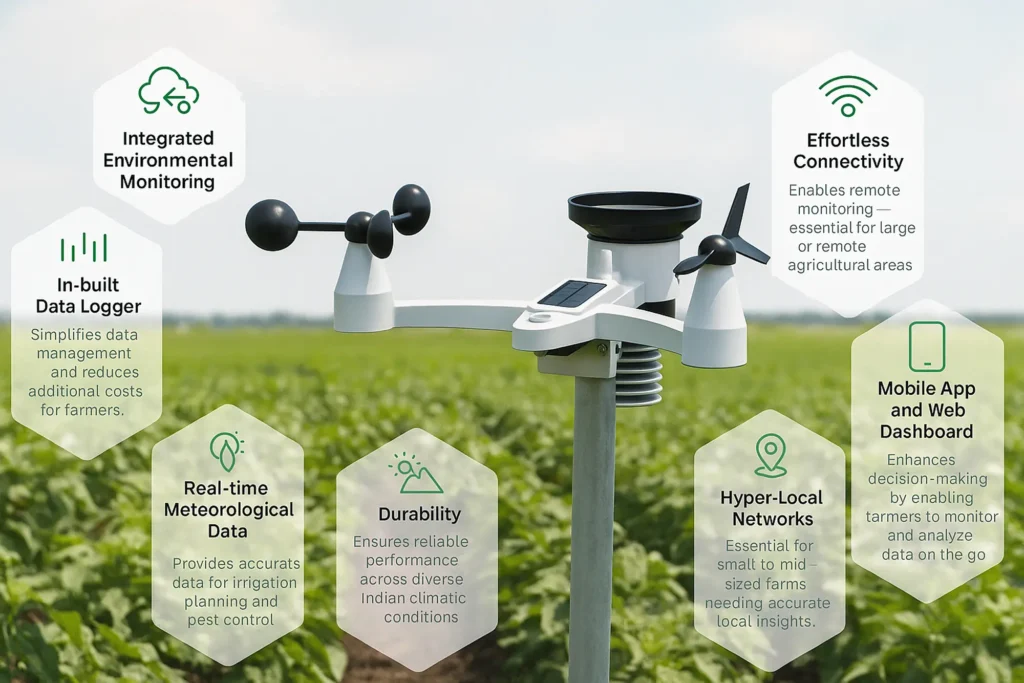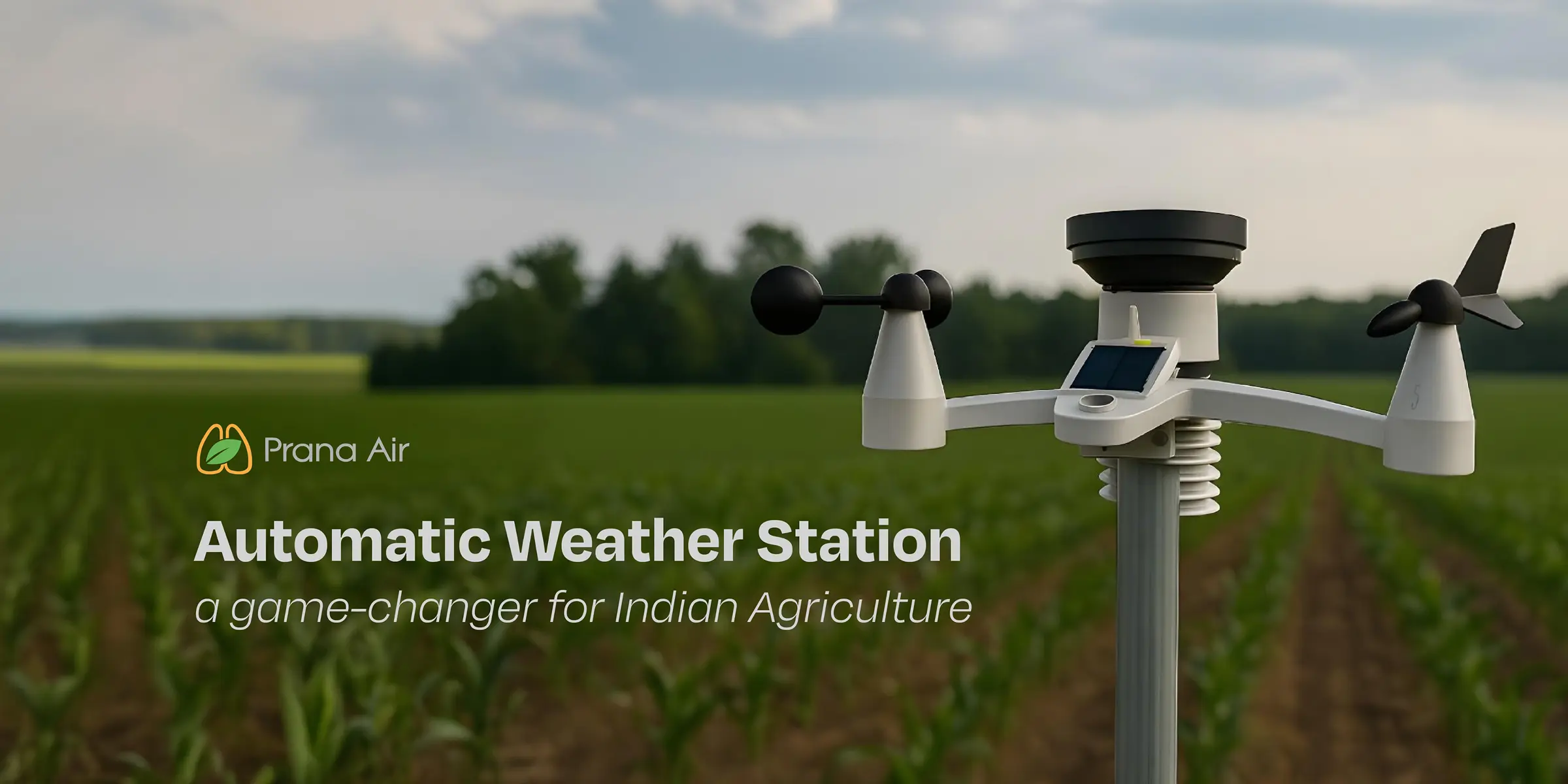Did you know that nearly 80% of marginal farmers in India are impacted by unpredictable climate events? Sudden rainfall, extreme heat, delayed monsoons, or unseasonal frost – these changes aren’t just inconvenient; they’re devastating for farmers who rely on stable weather patterns to secure their livelihoods. Thus, an automatic weather station for agriculture can be the game changer. Let us know how it can help.
According to multiple agriculture surveys and ICAR reports, a significant portion of annual crop loss in India is linked directly to weather fluctuations. Yet, many farms still operate without access to timely or accurate weather information. In an age where climate change is intensifying, relying on general forecasts or assumptions can cost farmers their entire season.
This is where Automatic Weather Stations (AWS) come into play, especially advanced, locally made systems like the one offered by Prana Air.
The Urgent Need for Weather Monitoring in Agriculture
India’s agriculture largely rain-fed. Over 55% of the net sown area depends on monsoonal rains, making it highly vulnerable to erratic weather conditions. Traditional methods of tracking weather — either through radio announcements, television forecasts, or local observation — are no longer sufficient to deal with fast-evolving climate conditions.
Moreover, marginal and small farmers (who constitute over 85% of India’s farming population) often lack access to real-time weather intelligence. This leads to mistimed irrigation, fertilizer application, pest control, and even harvesting, resulting in avoidable losses.
Introducing real-time, localized weather monitoring with a weather station for agriculture can directly empower farmers to make informed decisions. Automatic Weather Stations are built exactly for this purpose.
What is an Automatic Weather Station (AWS)?
An Automatic Weather Station is a sensor-based, real-time device designed to monitor multiple environmental parameters continuously. It collects and transmits weather data without the need for manual intervention. These stations typically record:

- Temperature and humidity
- Rainfall and precipitation intensity
- Wind speed and direction
- Solar radiation
- Barometric pressure
By delivering accurate weather data for a specific location, a weather station helps farmers plan, act, and adapt.
The Impact of Weather Stations on Farming Decisions
Here’s how Automatic Weather Stations are transforming agriculture on the ground:
1. Real-Time Decision Making
Instead of relying on broad regional weather forecasts, farmers can now receive hyperlocal weather data specific to their farm location. This means more accurate planning for irrigation, pesticide application, sowing dates, and harvest schedules.
2. Early Warning for Extreme Weather
Many Indian states face sudden rainfall or hailstorms during pre-harvest periods. With AWS, farmers can get advance warnings and alerts via SMS or mobile apps, helping them take protective action before a loss occurs.
3. Efficient Resource Management
Accurate weather information helps in optimizing water usage, reducing electricity consumption for pump operations, and minimizing fertilizer wastage. This not only cuts input costs but also supports sustainable farming.
4. Long-Term Climate Analysis
The continuous data stored by AWS can be used for multi-year analysis of local climate trends. Farmers, agri-tech startups, and institutions can use this data to develop climate-resilient strategies and cropping patterns.
Why Prana Air’s Weather Station is Ideal for Indian Agriculture?
Unlike many imported systems that aren’t well-adapted to Indian conditions, Prana Air’s Automatic Weather Station has been specifically designed for the Indian climate and agricultural use. Here’s why it stands out:
The Prana Air Weather Station: Features and Suitability
The Prana Air weather station is positioned as a robust solution for environmental monitoring, with specific features that align well with agricultural needs. Below is a detailed breakdown of weather station features and how they benefit agriculture:

| Feature | Details | Agricultural Benefit |
| Integrated Environmental Monitoring | Combines weather station with air quality monitoring (e.g., PM2.5, CO2). | Helps assess pollution impact on crops, crucial for air quality-sensitive regions. |
| In-built Data Logger | Access device data without a separate data logger. | Simplifies data management for farmers, reducing additional costs. |
| Effortless Connectivity | WiFi and GSM for seamless and reliable data transmission. | Enables remote monitoring, essential for large or remote farms. |
| Real-time Meteorological Data | Measures rainfall, UV index, light, solar radiance, wind speed, direction, humidity, and temperature. | Provides precise data for irrigation scheduling and pest management. |
| Durability | Withstands extreme heat, cold, rain, and snow. | Ensures longevity in diverse Indian climatic conditions. |
| Mobile App and Web Dashboard | Real-time data access on smartphones and computers, with comparison features. | Empowers farmers to monitor and analyze data on-the-go, enhancing decision-making. |
| Hyper-Local Networks | Provides real-time, location-specific weather data. | Critical for small to medium-sized farms needing precise local insights. |
The station’s box contents, including a weather station, rain gauge, pole, and anemometer, ensure easy installation, making it practical for farm use. Connectivity options like the AQI mobile app (available at iOS and Android) and web dashboard log in further enhance accessibility.
Weather Station Impact on Agriculture:
- Precision Farming: Accurate weather data enables farmers to tailor activities like planting and irrigation to specific field conditions, potentially increasing yields.
- Adaptation to Climate Change: Real-time data helps farmers adapt to erratic rainfall and temperature rises, reducing losses. For instance, studies show that 82% of farmers perceive a rise in temperature, and 85% note altered rainfall patterns, which AWS can help manage.
- Cost-Effectiveness: While there is an initial investment, the long-term benefits of increased yields and reduced losses make it a viable option. Research suggests AWS can optimize resource use, leading to cost savings, especially important for marginal farmers.
- Empowering Marginal Farmers: The user-friendly interface, including mobile apps, ensures even small farmers can leverage technology, levelling the playing field in a sector where access to advanced tools is often limited.
Final Thoughts
The climate clock is ticking — and Indian farmers are on the frontline. While policy changes and subsidies are important, real resilience will come from real-time information. Installing an automatic weather station, such as the one from Prana Air, offers an immediate, scalable, and sustainable way to adapt agriculture to today’s climate challenges.
From individual farms to cooperatives and research institutions, Prana Air’s weather station is more than just a data logger — it’s a decision-making tool, a cost saver, and a safeguard for tomorrow’s crops.
To learn more about how Prana Air’s Automatic Weather Station can support your farming or agri-business operations, visit our weather station product page or reach out to our team.

